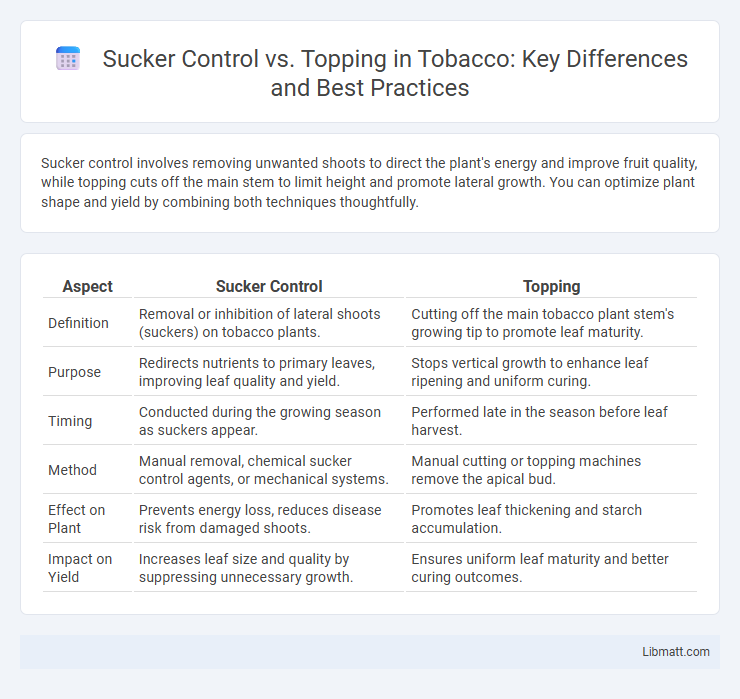Sucker control involves removing unwanted shoots to direct the plant's energy and improve fruit quality, while topping cuts off the main stem to limit height and promote lateral growth. You can optimize plant shape and yield by combining both techniques thoughtfully.
Table of Comparison
| Aspect | Sucker Control | Topping |
|---|---|---|
| Definition | Removal or inhibition of lateral shoots (suckers) on tobacco plants. | Cutting off the main tobacco plant stem's growing tip to promote leaf maturity. |
| Purpose | Redirects nutrients to primary leaves, improving leaf quality and yield. | Stops vertical growth to enhance leaf ripening and uniform curing. |
| Timing | Conducted during the growing season as suckers appear. | Performed late in the season before leaf harvest. |
| Method | Manual removal, chemical sucker control agents, or mechanical systems. | Manual cutting or topping machines remove the apical bud. |
| Effect on Plant | Prevents energy loss, reduces disease risk from damaged shoots. | Promotes leaf thickening and starch accumulation. |
| Impact on Yield | Increases leaf size and quality by suppressing unnecessary growth. | Ensures uniform leaf maturity and better curing outcomes. |
Introduction to Sucker Control and Topping
Sucker control and topping are essential horticultural techniques used to manage plant growth and improve crop yield. Sucker control involves removing unwanted shoots from the base or joints of plants to direct energy toward main stems, while topping entails cutting off the plant's upper portion to encourage bushier growth and increased fruit production. Understanding these methods helps you optimize plant structure and maximize harvest efficiency.
Understanding Plant Growth Habits
Sucker control targets the vigorous shoots that emerge from the base or nodes of plants, preventing energy diversion and promoting healthier main stems. Topping involves cutting the main stem to encourage lateral branch growth and a bushier structure, influencing the overall plant shape and yield. Understanding your plant's growth habits helps determine whether sucker control or topping will optimize its health and productivity.
What Is Sucker Control?
Sucker control refers to the pruning technique used to remove unwanted shoots, or "suckers," that grow from the base or roots of a plant, diverting energy away from the main stem and fruit production. Topping, on the other hand, involves cutting the top portion of the plant to encourage bushier growth and increased yield. Understanding sucker control helps you maintain healthier plants by directing nutrients to productive branches and improving overall growth efficiency.
What Is Topping?
Topping is a pruning technique where the main stem of a plant is cut to encourage lateral growth and a bushier structure. Unlike sucker control, which targets unwanted shoots emerging from the plant's base or root system, topping directly shapes the plant's overall form and stimulates multiple new growth points. You can use topping to optimize light exposure and airflow, promoting healthier plants and increased yields.
Key Differences Between Sucker Control and Topping
Sucker control involves selectively removing unwanted shoots or lateral growths to enhance airflow and focus the plant's energy on main branches, while topping refers to cutting off the top portion of the main stem to encourage bushier growth by stimulating multiple new shoots. The key difference lies in sucker control targeting side growth to maintain plant shape and health, whereas topping drastically alters the plant's structure to increase yield potential. Understanding these techniques helps you optimize plant development based on your cultivation goals.
Benefits of Sucker Control
Sucker control enhances plant health by redirecting energy from unwanted shoots to main stems, improving fruit quality and yield in crops such as tomatoes, peppers, and grapevines. It reduces disease risk and increases airflow, contributing to healthier plants and more efficient photosynthesis. Effective sucker management also simplifies maintenance and harvesting, leading to higher productivity in horticulture and agriculture.
Advantages of Topping
Topping cannabis plants encourages bushier growth by promoting multiple main colas, which can increase overall yield and light exposure for your buds. This method allows better airflow and canopy management, reducing the risk of mold and pest infestations. By distributing energy to several growth points, topping helps create a more balanced and resilient plant structure compared to solely removing suckers.
Risks and Drawbacks of Each Method
Sucker control can cause plant stress and reduced airflow, increasing the risk of fungal diseases if not managed carefully. Topping often results in slower growth and potential shock to your plant, as it removes the apical dominance and disrupts natural hormone balance. Both methods require precise timing and technique to avoid damaging the overall health and productivity of your plants.
Best Practices for Sucker Control and Topping
Effective sucker control involves regularly removing unwanted shoots at the base to promote healthy growth and improve airflow, minimizing disease risks in your plants. Topping, the practice of cutting the main stem, encourages bushier growth and increased yields by redirecting the plant's energy to lateral branches. Combining precise sucker removal with strategic topping ensures optimal plant structure and maximizes production.
Choosing the Right Method for Your Plants
Choosing between sucker control and topping depends on your gardening goals and plant species. Sucker control targets unwanted shoots at the base or along stems, preserving the plant's primary structure for healthier growth. Topping involves cutting the main stem to encourage bushier growth, ideal for maximizing yield in certain crops like tomatoes or cannabis.
Sucker control vs topping Infographic

 libmatt.com
libmatt.com